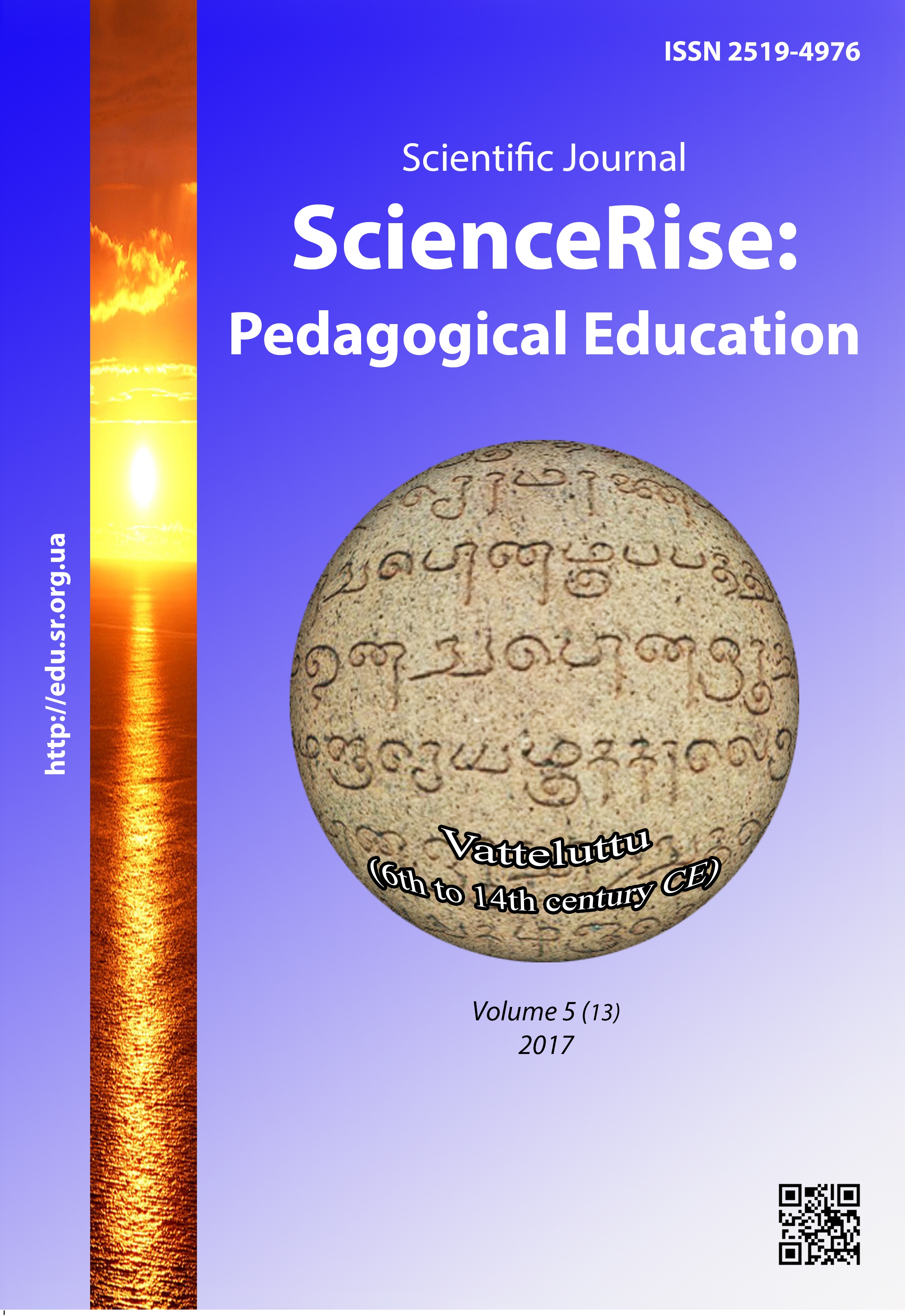Projection of communicative interaction as a component of assessment and control strategies in teaching languages at university
DOI:
https://doi.org/10.15587/2519-4984.2017.102899Keywords:
control and assessment strategy, communicative interaction, projection, perceptive type of activityAbstract
In the article are demonstrated the results of the study of conditions and possibilities of realization of the project of communicative interaction between students and teachers in the strategy of control and assessment of teaching language. The conclusion was made that the neglect of projection of communicative algorithms and procedures results in the incomplete taking into account of factors of qualitative and correct final exam on language. That is why the possibilities of feedback of study participants, language cognition, experience of speaking in communicative situations, initiative dialog and language partnership are lost. The author assumes that the projection of communicative interaction in the control and assessment strategy essentially and positively influences the check-up and development of language knowledge and speaking skills of students at an exam. The main observation was realized with the involvement of students of engineer and philological specialties of Ukrainian universities, who pass exams in English. It was elucidated that a condition of a successful exam is changes and correction of the perceptive image of communicative interaction between students and teachers at the final control. Statements about necessary changes in the project of communication between a teacher and a student became a conclusion of the research. These changes relate to: features and role of a question at an exam, put by a teacher to a student and vice versa; speaking roles and stereotype genres of teacher’s and student’s speaking; initiative in a dialog; mistakes in speaking at a speaking exam. The author of this article offers the bloc of operations for the activity project that positively influence the perceptive image of an exam in teachers and students. The correct perceptive image of an exam gives a possibility to create communicative situations of the full value communication between teachers and students. Speaking in these situations must become an object of the final control of language knowledge and speaking skills and enrich the experience of participants of an exam by new models of communicative interaction
References
- D’yachenko, V. K. (2001). Novaya dydaktyka. Moscow: Narodnoe obrazovanye, 496.
- Liubashenko, O. (2007). Linguodydaktychni strategii priektuvannya protsesu navchannya ukrayinskoyi movy u vyshchiy shkoli [Linguodidactic strategy: framing process of learning the Ukrainian language in high school]. Nizhin: Aspekt-Poligraf, 296.
- Mandl, H., Friedrich, H. F. (Eds.) (2006). Handbuch Lernstrategien. Gottingen: Hogrefe, 414.
- Griffiths, C. (2013). The Strategy Factor in Successful Language Learning. Bristol: Mutilingual Matters, 240.
- Oxford, R. (2011). Teaching and Researching Language Learning Strategies. Harlow: Pearson Education Limited. doi: 10.4324/9781315838816
- Orlovskaya, I. S. Lichnostno-deyatelnostnaya strategiya obucheniya inostrannomu yazyku.
- Shchukin, A. N. (2010). Sovremennyye intensivnyye metody i tekhnologii obucheniya inostrannym yazykam. Moscow: Filomatis, 188.
- Pentyliuk, M. I. (2011). Aktualni problemy suchasnoi linhvodydaktyky. Kyiv: Lenvit, 256.
- Alderson, J. C., Banerjee, J. (2001). Language testing and assessment (Part I). Language Teaching, 34 (4), 213–236. doi: 10.1017/s0261444800014464
- Bachman, L. F. (1990). Fundamental considerations in language testing. Oxford: Oxford University Press, 240.
- Green, A. (2014). Exploring Language Assessment and Testing: Language in Action. New York: Routledge, 272.
- Petrashchuk, O. (1999). Testovyi kontrol' u navchanni inozemnoyi movy v seredniy zahal'noosvitniy shkoli [Testing control in foreign languages teaching at school]. Kyiv: Vydavnychyy tsentr KDLU, 261.
- Kvasova, O. G. (2009). Osnovy testuvannya inshomovnykh navychok i vmin' [Basis of Testing of foreign skills]. Kyiv: Lenvit, 119.
- Pavlova, T. P. (2006). Kompleksne testuvannia yak faktor modernizatsii navchannia inozemnyh mov. Problemy suchasnoyi pedagogichnoyi osvity, 11 (2), 206–214.
- Brookhart, S. M. (2008). How to Give Effective Feedback to Your Students. Alexandria.
- Skurativska, M. O. (2009). Suchasni metody na tehnologii vykladannia mov u vyshchii shkoli Ukrayiny. Available at: http://intkonf.org/skurativska-mo-suchasni-metodi-ta-tehnologiyi-vikladannya-inozemnih-mov-u-vischiy-shkoli-ukrayini/
- Vashchuk, F. G. (2011). Integratsia v Evropeiskii osvitnii prostir: zdobutky, problemy, perspektyvy. Uzhhorod: ZakDu, 560.
- Common European Framework of Reference for Languages: learning, teaching, assessment (2016). Strasbourg: Language Policy Unit, 260. Available at: https://www.coe.int/t/dg4/linguistic/Source/Framework_EN.pdf
- Murav'eva, G. E. (2002). Teoreticheskie osnovy proektirovaniya obrazovatel'nyh processov v shkole. Moscow: Prometey, 200.
- Stazicker, J. (Ed.) (2015). The Structure of Perceptual Experience. West Sussex: Wiley, 154. doi: 10.1002/9781119061113
- Broadbent, D. E. (1958). Perception and communication. London: Pergamon Press, 340. doi: 10.1037/10037-000
Downloads
Published
How to Cite
Issue
Section
License
Copyright (c) 2017 Olesia Liubashenko

This work is licensed under a Creative Commons Attribution 4.0 International License.
Our journal abides by the Creative Commons CC BY copyright rights and permissions for open access journals.
Authors, who are published in this journal, agree to the following conditions:
1. The authors reserve the right to authorship of the work and pass the first publication right of this work to the journal under the terms of a Creative Commons CC BY, which allows others to freely distribute the published research with the obligatory reference to the authors of the original work and the first publication of the work in this journal.
2. The authors have the right to conclude separate supplement agreements that relate to non-exclusive work distribution in the form in which it has been published by the journal (for example, to upload the work to the online storage of the journal or publish it as part of a monograph), provided that the reference to the first publication of the work in this journal is included.








